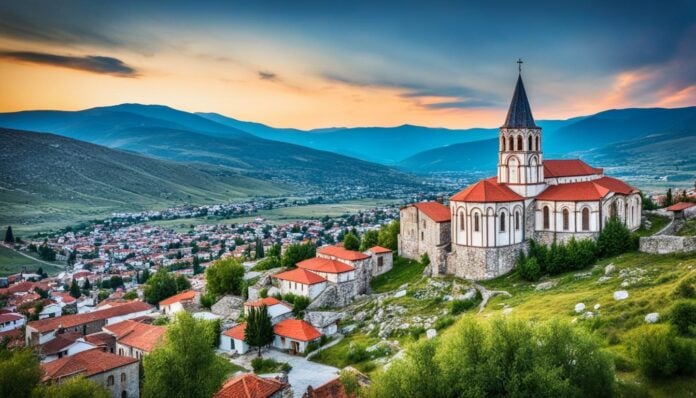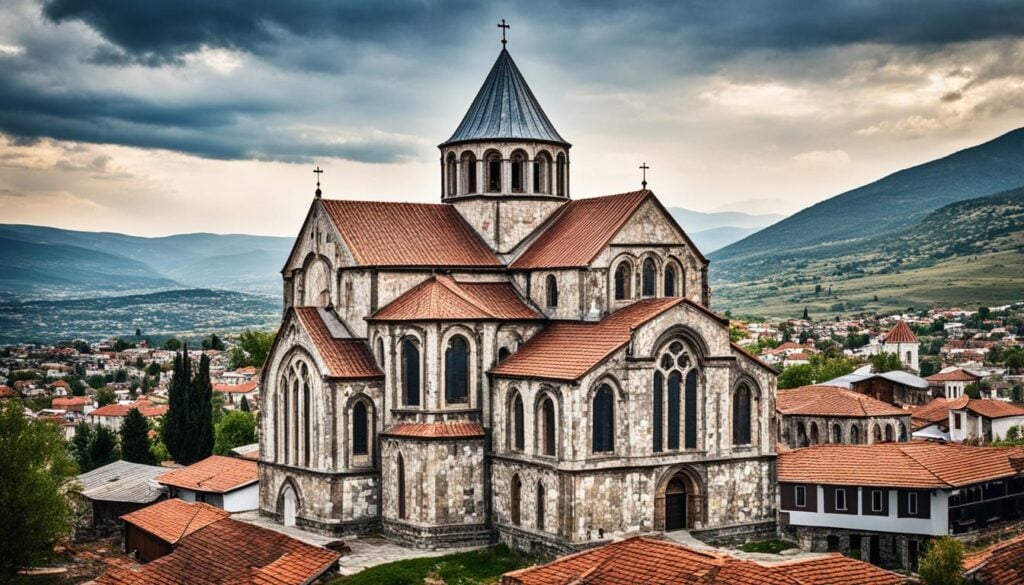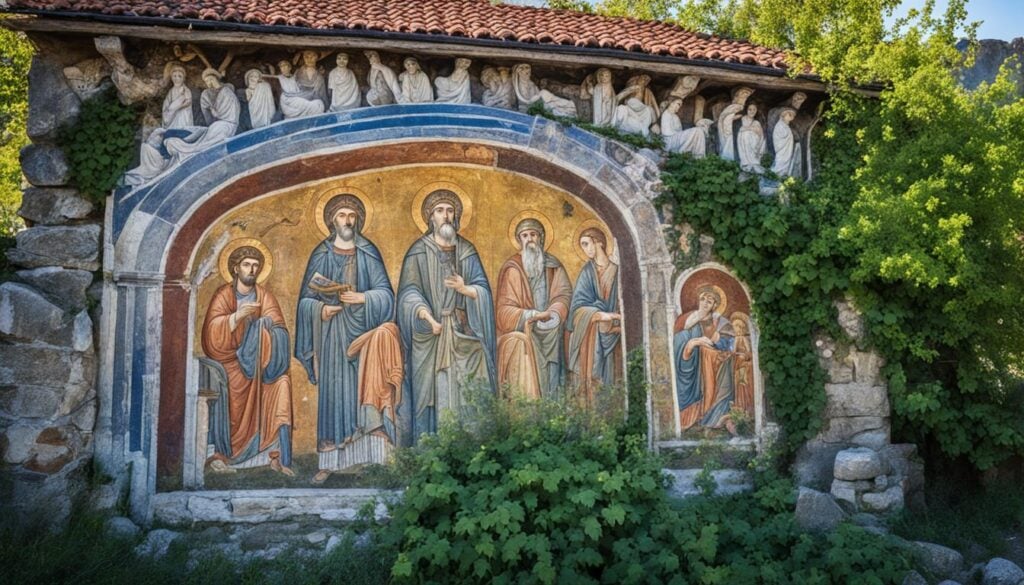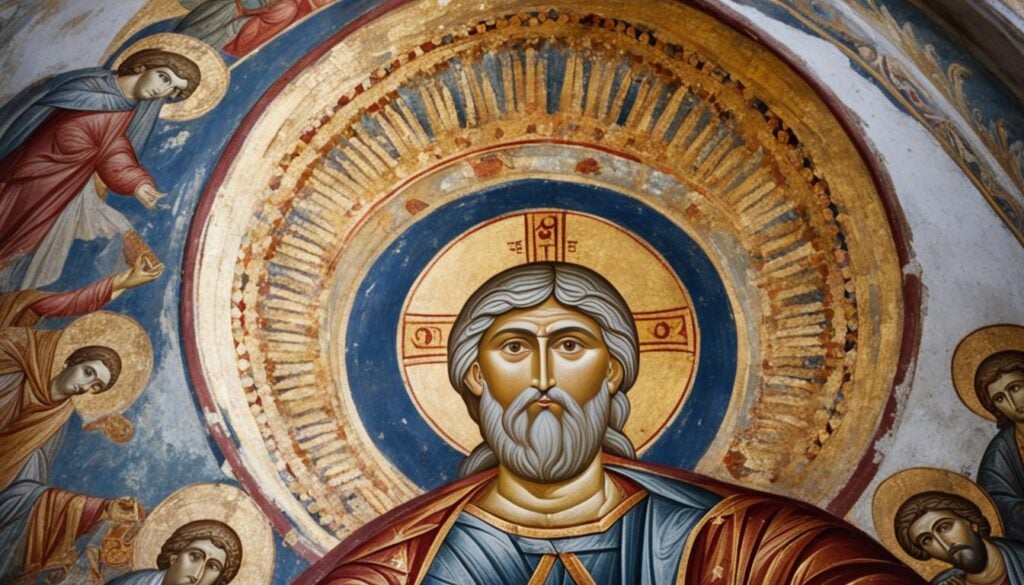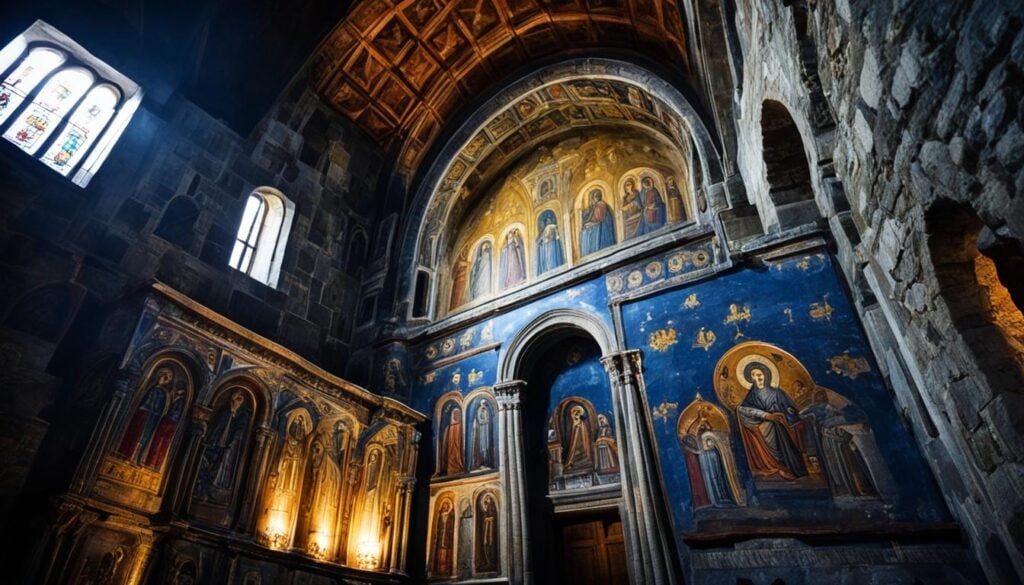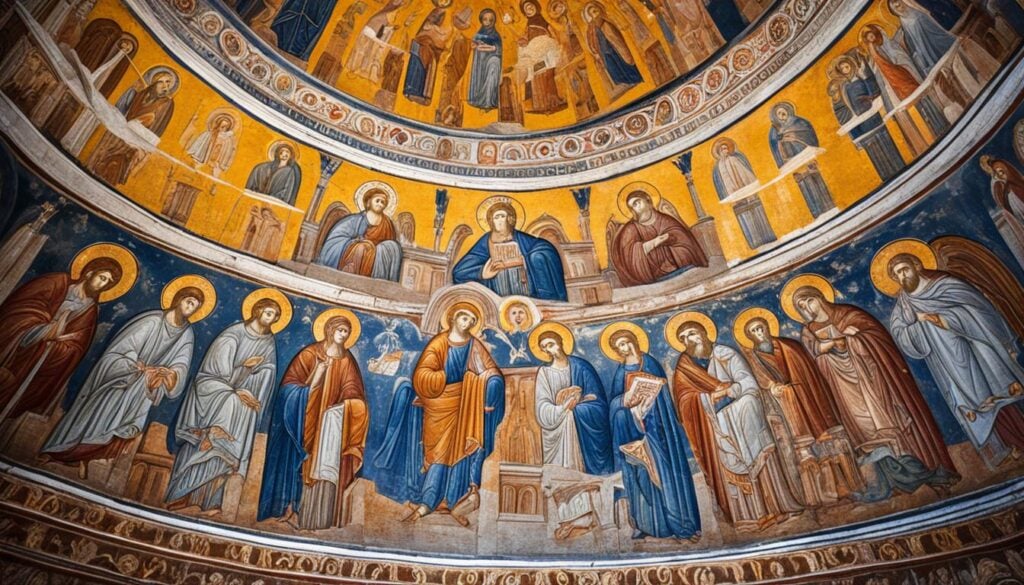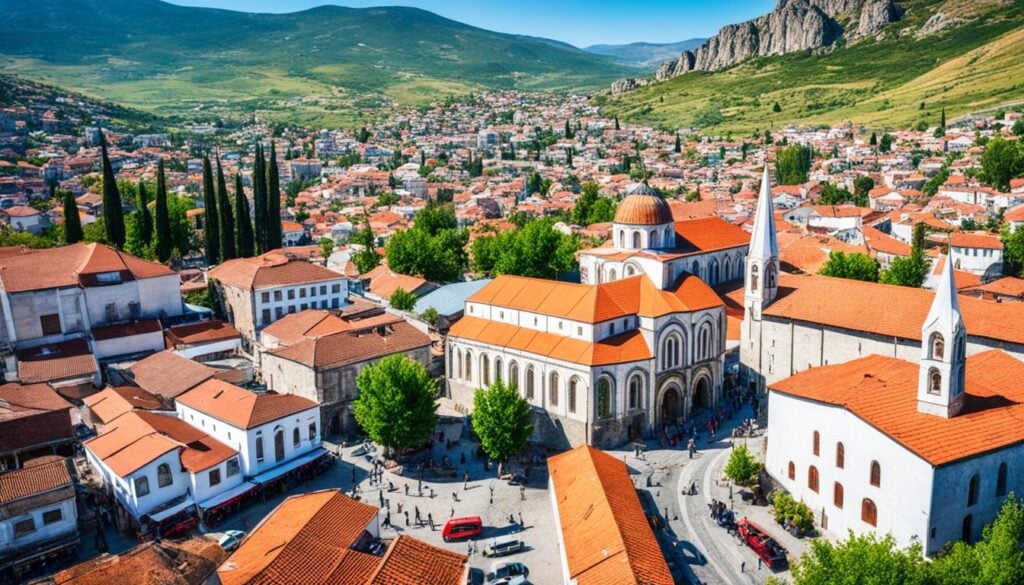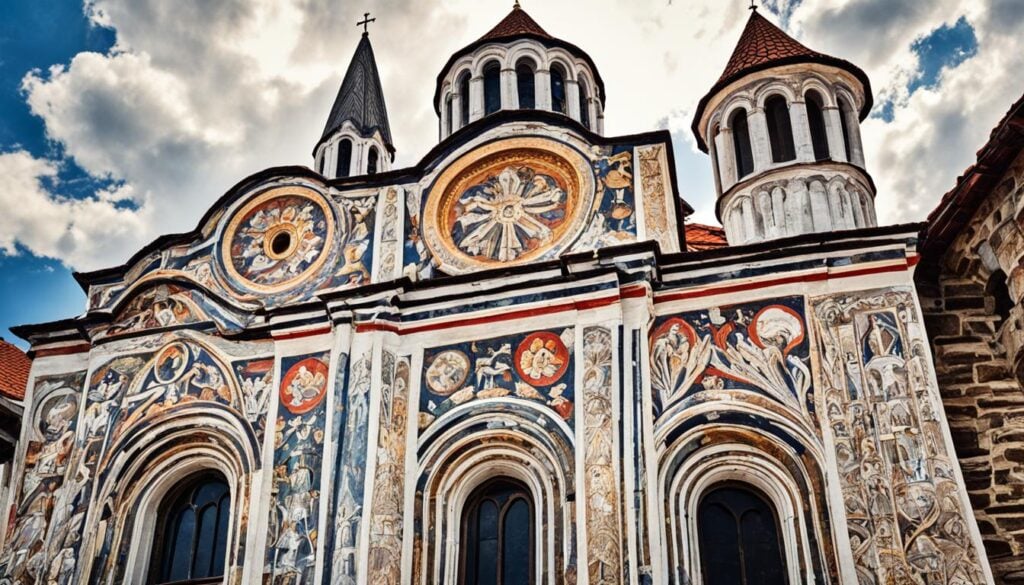Have you ever wondered about the hidden treasures in ancient Byzantine churches? Join us to uncover the secrets of Prilep’s churches and frescoes. You’ll see the beautiful world of Byzantine art in Prilep. With us, you’ll explore historical landmarks and see art by skilled artists from centuries ago.
Why should you explore Prilep’s Byzantine art and historical sites? These places are full of enchanting stories and hidden paintings. It’s a chance to see the rich details in the art, like the symbols and stories.
Prilep’s sites show its historical and artistic richness. You’ll find everything from big basilicas to small chapels. Each one tells a story of beauty and faith.
Who painted these hidden frescoes? How did they do it? Let’s discover the artists behind these works. We’ll learn about their lives, skills, and the world that influenced their art.
Come with us to learn about Prilep’s Byzantine art. Be ready to see stunning artwork. This journey will show you the city’s incredible past and how it inspires today.
The Magnificent Byzantine Churches of Prilep
Prilep, found in North Macedonia, is celebrated for its stunning Byzantine churches. These structures represent the historical and cultural importance of the area well.
The Church of St. Nicholas, built in the 12th century, is especially noteworthy. It features detailed frescoes and unique architecture. Once inside, you’ll feel the deep spiritual atmosphere of this place.
“The Byzantine churches of Prilep are not merely structures built with stones and mortar. They are living legacies, encapsulating centuries of religious devotion, cultural identity, and artistic brilliance.”
The Church of St. Demetrius is another highlight. It’s famous for its beautiful frescoes of biblical stories and saints. The craftsmanship in these works is truly amazing.
Visiting these churches allows you to see the blend of architecture and meaning. They are not just buildings but symbols of faith and art. Every church tells a story, inside and out, through its design and paintings.
Discovering the Macedonian Byzantine Tradition
Prilep’s Byzantine churches are both wonders of design and important cultural signs. They are from a time when Macedonia was a key part of the Byzantine Empire.
These churches show the grandeur of Byzantine architecture. They have large domes and beautiful artwork. This artwork tells religious stories and teachings, adding to the churches’ significance.
Exploring Prilep’s churches is like traveling through history. Each church is a work of art that keeps a part of the region’s past alive. They show the strength of the people’s faith and preserve their cultural history.
Standing before Prilep’s churches, you can see the efforts to keep their beauty alive. Restoration and education are key parts of this work. The local community is dedicated to safeguarding these important sites.
Next, we’ll look at the hidden frescoes of Prilep’s churches. These artworks reveal even more about the area’s rich history.
Unveiling the Hidden Frescoes of Prilep
Get ready to be amazed by the frescoes in Prilep, a city full of hidden Byzantine art. Its historic churches are a goldmine of hidden jewels. The incredible paintings show us the culture and art of the Byzantine period.
Start at the Church of St. Nikola, and feel the magic of its hidden frescoes. In the low light, see the colors and details burst to life. You’ll see Bible stories and saint tales in vivid detail, showing the artist’s hard work.
But that’s just one place. Prilep’s other churches also have hidden frescoes, like the Church of the Holy Archangels Michael and Gabriel. Don’t miss the Church of St. Demetrius and the Church of St. Mary for their awe-inspiring art.
Some frescoes have been restored, but many still need work. Time has taken a toll on their beauty, but not their spirit. Even worn, they still impress with their ancient talent.
Learning about these artworks means knowing their history. They weren’t just pretty pictures. They taught stories from the Bible to those who couldn’t read, helping spread the Church’s messages widely.
Exploring Prilep’s hidden frescoes is like traveling through time. Try to imagine the effect these artworks had on Byzantine worshipers. They are more than just art; they’re our portal to an ancient world of faith and creativity.
| Church | Fresco Highlights |
|---|---|
| Church of St. Nikola | Scenes from the Book of Genesis |
| Church of the Holy Archangels Michael and Gabriel | Depictions of the Archangels and heavenly realms |
| Church of St. Demetrius | Life of Saint Demetrius through vibrant frescoes |
| Church of St. Mary | Portraits of the Virgin Mary and scenes from her life |
Exploring Prilep’s Cultural Sites
The Byzantine churches and frescoes highlight Prilep’s culture. But the city boasts more, like unique religious art and historic places. Dive into Prilep’s tapestry, with its blend of monasteries, and detailed sculptures.
Holy Archangel Michael Monastery is a top site near Prilep. Built in the 14th century, it offers beautiful architecture. Its location also provides amazing views of the area.
Visit the Troglodyte Village to see how people lived in the past. It’s set within cliffs and shows historic cave dwellings. This spot provides a look at ancient lifestyles.
At the St. Nikola Monastery, enjoy great religious art. Its frescoes and woodcarvings display local talents. This gem reflects Prilep’s rich cultural heritage.
Prilep has more to offer than religious landmarks. The Marko’s Towers is a prime example. These are medieval fortifications with stunning views. They once protected the city against invaders.
Here is a list of Prilep’s cultural sites:
- Holy Archangel Michael Monastery
- Troglodyte Village
- St. Nikola Monastery
- Marko’s Towers
These cultural sites are windows into Prilep’s history and art. They cater to those who love religious art, ancient buildings, or the city’s culture. Visit these places to fully experience Prilep.
A Glimpse into Prilep’s Historical Legacy
Prilep, in North Macedonia, is celebrated for its rich history. It’s known for its Byzantine art. This ancient city is full of stories and myths.
Prilep has many historical sites that highlight its culture. The city is filled with amazing Byzantine churches and detailed frescoes. These show how important Prilep was in history.
The Magnificent Byzantine Churches
Prilep’s Byzantine churches are highlights. These old buildings are breathtaking. They are centuries old and still beautiful.
St. Nicholas and St. Mary’s are famous. St. Nicholas has a beautiful dome and inside. While St. Mary’s has stunning art.
These churches were more than just places of worship. They are key parts of Prilep’s history. They show the city’s connection to the Byzantine era.
Unveiling the Hidden Frescoes
Prilep is also known for its hidden frescoes. They are all over the city. These art pieces show us life in Prilep long ago.
They’re found in many places. Like monasteries, caves, and even some homes. Each fresco is carefully made, showing the skill of the artists.
The Cultural Significance of Byzantine Art
Byzantine art is very important in Prilep. It shaped the city’s culture and faith. The art in the city’s buildings and icons shows this connection.
They tell stories from the Bible and show great detail. These artworks capture the heart and soul of Byzantine culture. They are made with great care and love.
Visitors today can see this amazing art. They can enjoy famous places and hidden treasures. Prilep welcomes anyone interested in art or history.
Are you a fan of art or love exploring history? Prilep is a great place for you. Its Byzantine art will amaze and inspire you. So, visit Prilep and see its beautiful sites and art for yourself.
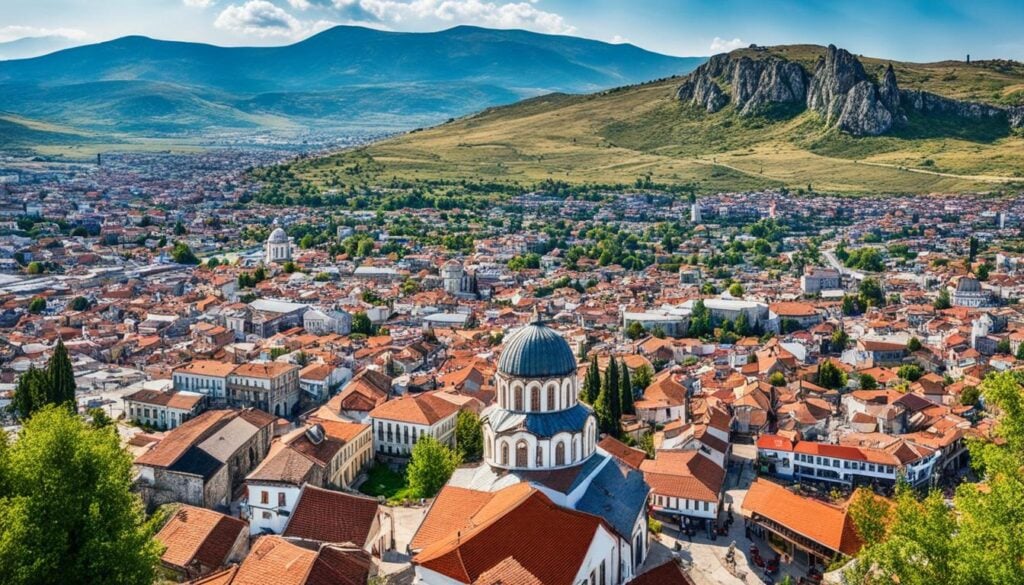
The Masters behind the Hidden Frescoes
In the hidden corners of Prilep, beautiful frescoes wait to be discovered. They are the work of Byzantine painters with amazing talent. Their art shows the deep history and creativity of the city. These master artists have truly made their mark in the world of art.
Prilep’s Byzantine painters carefully painted scenes from holy books and tales. They used vibrant colors, deep symbolism, and perfect layout. All this makes their work truly captivating.
These painters learned and honed their skills over many years. They mixed Byzantine and local art styles. The result is a unique painting style with bright colors and spiritual themes.
“The hidden frescoes in Prilep showcase the immense skill and creativity of Byzantine painters. The intricate details and rich symbolism are testaments to their artistry.” – Art critic
They added rich, spiritual meaning to their art. Every part of their paintings tells a story about faith and deeper truths. Even now, these secret frescoes in Prilep touch the hearts of those who love art.
Exploring the Techniques of Byzantine Painters
Byzantine artists had special ways to create their art. They favored the fresco method, painting on fresh plaster. This made the paint soak into the walls, keeping their art vibrant for ages.
They also loved using egg tempera. This paint mix, made from egg yolk and color, was durable and vivid. It let them show tiny details with real skill and care.
These artists weren’t afraid of using gold. They would add golden touches to their work. Gold showed the holiness and magic of their paintings, making them even more special.
| Techniques used by Byzantine Painters | Examples |
|---|---|
| Fresco technique | Hidden frescoes in Prilep depicting biblical scenes |
| Egg tempera | Intricate detailing in the frescoes of St. John the Theologian Church |
| Gold leaf embellishments | The shimmering gold accents in the frescoes of St. Panteleimon Monastery |
With these methods and their deep religious understanding, the artists in Prilep created stunning masterpieces. Their frescoes hold a special place in art history.
Admiring the Byzantine Iconography
Exploring the Byzantine churches in Prilep reveals their charm. The iconography is both detailed and symbolic. It showcases beautiful religious figures, stories, and symbols from the Bible.
Iconography plays a key role in Byzantine art. It was used to teach religion and deepen spiritual connections. The artists told stories and showed the presence of God through their craft.
Byzantine art focuses on spiritual messages more than realism. The use of long figures, soft colors, and gold makes the art feel heavenly. It encourages deep thoughts and amazement.
The churches in Prilep feature stunning frescoes. They show the artist’s skill and faith. The artwork tells stories from the Bible and honors important Christian figures.
At the Church of St. Nicholas, for example, scenes from the Bible cover the walls and ceilings. They make the church not just beautiful but also a place of teaching for believers.
Understanding Byzantine iconography means knowing its symbols. Elements like color, position, and gestures tell deep truths about the faith. They point to important religious ideas.
Gold stands for Christ’s eternal nature, and blue is for heaven and the Virgin Mary. Halos represent holiness, and special hand signs show a spiritual bond with God.
Studying Prilep’s Byzantine art gives us insights into its history and spirituality. By looking at the iconography, we learn about religious beliefs and creativity from the Byzantine times.
The Symbolism of Byzantine Iconography
To truly understand the Byzantine art in Prilep, we must look at its symbols:
| Symbol | Meaning |
|---|---|
| Gold | Divinity and eternity |
| Blue | Heavenly realms, the Virgin Mary |
| Halo | Sanctity and divine presence |
| Gestures | Prayer, spiritual connection |
Preserving Prilep’s Artistic Heritage
Prilep is famous for its deep cultural roots. It shines because of its ancient art and unseen frescoes. Keeping these treasures safe means coming generations can witness Prilep’s wonder and history.
Prilep’s hidden frescoes are now coming back to life. After years of being covered up, they are being cleaned and restored. This work shows the amazing art from the Byzantine era.
Archaeologists and art experts are working hard in Prilep. They’re digging deep to find out more about the city’s past. Their efforts make sure Prilep’s history is not forgotten, letting others learn from and enjoy its rich heritage.
Conservation Techniques for Prilep’s Byzantine Churches and Frescoes
Preserving Prilep’s art involves special methods and skills. Specialists use different techniques to protect frescoes and buildings. They focus on cleaning, stabilizing, consolidating, and even retouching the art.
These methods help keep Prilep’s artistic past safe. They make it possible for the next generations to see and feel the history behind the hidden frescoes and ancient churches.
Continued Efforts for Preservation
Prilep’s art heritage preservation is an ongoing mission. Many groups work together to look after the city’s ancient sites and frescoes.
Education and awareness are key to caring for Prilep’s culture. They help make people realize why this heritage is important. Everyone’s help ensures Prilep’s art is around for years to come.
Together, we can explore and appreciate Prilep’s rich past. Thanks to everyone working on this, Prilep’s treasures keep drawing people from all over the world.
| Conservation Techniques | Description |
|---|---|
| Cleaning | Removal of dirt, grime, and pollutants from frescoes and architectural elements. |
| Stabilization | Reinforcing and securing fragile structures to prevent further damage and deterioration. |
| Consolidation | Strengthening loose or fragmented frescoes and architectural elements through adhesive or consolidant application. |
| Retouching | Reintegrating missing areas or damaged sections of frescoes with seamless inpainting techniques. |
Exploring the Prilep Art Scene
Prilep is more than a city full of old culture and Byzantine art. It’s also a lively place for today’s artists. These artists find their creative spark in Prilep’s history. The art there reflects the city’s long art tradition.
Visiting Prilep is a treat for those who love art. You can see modern art that takes inspiration from the old Byzantine style. Artists mix old techniques with their own ideas. The result is art that celebrates Prilep’s rich past.
The Prilep Gallery of Contemporary Art is a must-see for art fans. It features art from both local and global artists. This gallery is where artists get to share their work. It opens doors for people to see the vibrant Prilep art scene.
Prilep doesn’t stop at galleries. It hosts art festivals and events during the year. These events are for everyone who loves art. You can see paintings, enjoy music, join workshops, and see interactive art. It makes the city buzz with creative energy.
The city’s art isn’t just indoors. Prilep’s walls are painted with bright murals and street art. This adds a fun, unexpected touch to the city’s scene. Walking the streets feels like a free art show, with surprises at every turn.
In the end, Prilep’s art scene is thriving. It bridges the ancient and modern, celebrating art in many forms. Whether you like galleries, festivals, or street art, Prilep has something special for every art lover.
Experiencing Prilep’s Byzantine Treasures
Prilep packs a punch with its rich history and culture. This Macedonian city is full of ancient charm. Especially dazzling are the Byzantine churches and frescoes that tell stories of old.
In Prilep, you’ll find a variety of Byzantine churches. Each church is unique, decorated with stunning artwork. For instance, the Saint Nicholas Church boasts beautiful frescoes. Saint Demetrius Church shows off intricate mosaics.
Hidden frescoes in Prilep’s churches and monasteries are true wonders. They tell religious and biblical tales in vivid color and detail. It’s clear that these works were crafted with great care by skilled hands.
If you’re visiting, don’t miss the Church of the Holy Salvation. Inside, you’ll see incredible frescoes of the Nativity and Crucifixion. They highlight the church’s importance and the skill of the artists.
These Byzantine churches are more than places of worship. They’re living history books. They show Prilep’s strong connection to the Byzantine Empire. Their walls tell stories of centuries past.
The beauty of Prilep’s Byzantine churches is awe-inspiring. They’re a must-see for anyone interested in art, history, or spirituality. Start exploring to discover Macedonian Byzantine heritage at its finest.
Conclusion
In conclusion, Prilep’s Byzantine churches and frescoes are super important. They keep the city’s history and art alive. These buildings show how skilled ancient workers were.
Visit Prilep’s cultural spots to see Byzantine art up close. You’ll be amazed by the fine details in the frescoes. These art pieces show the talent of artists from long ago.
Prilep is working hard to save its art and history. This makes it perfect for art fans and those who love history. In Prilep, you can see amazing Byzantine images and enjoy modern art.
Exploring Prilep’s Byzantine treasures is like meeting the past. It lets us understand art’s true meaning. Make sure you see these special artworks when you’re in Prilep.

































